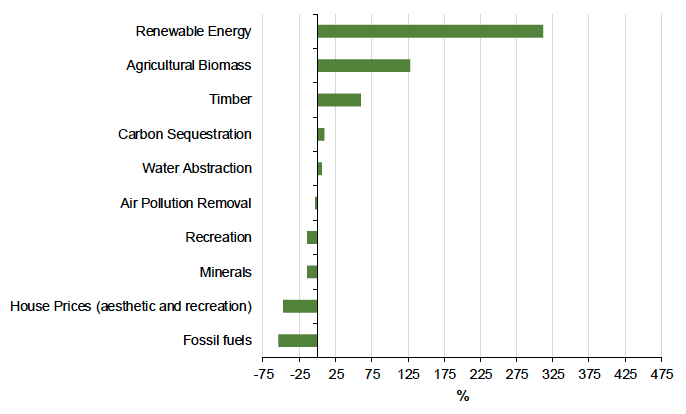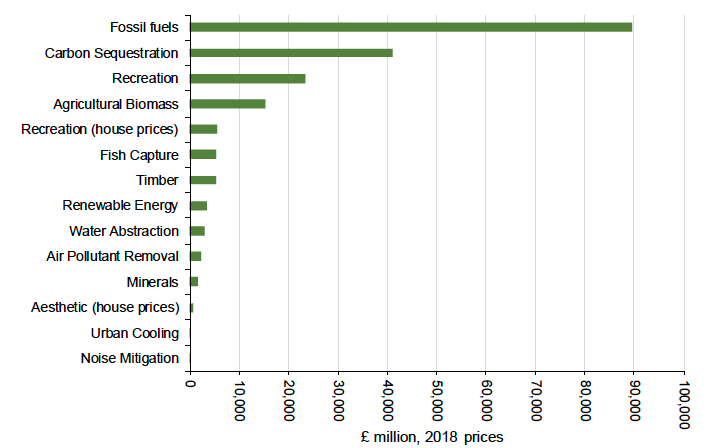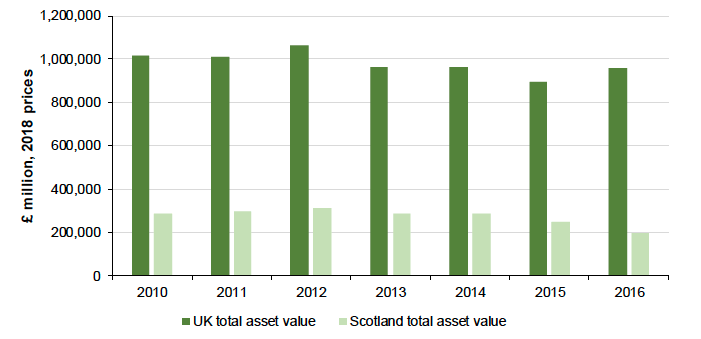Scottish Natural Capital Accounts: 2020
This report gives estimates of the quantity and value of services supplied by Scottish natural capital covering:
Agricultural biomass
Fish capture
Timber
Water abstraction
Minerals
Fossil fuel
Renewable energy
Carbon sequestration
Air pollution removal
Noise mitigation
Urban cooling
Recreation
8. Asset valuation
Here we present the asset values of Scottish natural capital by service. These values are estimated by capitalising the annual flow of services from the natural resource that are expected to take place over a projected period, known as the asset life. The annual environmental service flows provide the basis for the projected flows. This is a method known as net present valuation (NPV), which is explained in more detail in the methodology section.
Some of the environmental services presented in this article are produced from renewable resources whose stock is not exhausted over time, such as Scottish woodland delivering carbon sequestration. For these renewable resources, a 100-year asset life has been assumed. The non-renewable abiotic resources presented in this article are minerals and fossil fuels, where an asset life of 25 years has been assumed.
Since 2010, out of all the measured ecosystem services, the asset value of fossil fuels has declined by the greatest amount (over 50%) in 2016. This was closely followed by the asset value of the benefits of accessible green and blue spaces reflected in house prices, which decreased by 47% between 2010 and 2016. Meanwhile, renewable energy increased by four times since 2010.
Percentage change in asset value by service from 2010, Scotland, 2016

Source: Office for National Statistics
Notes:
1. Excluding the comparison of asset values for fish capture, urban cooling and noise mitigation, because of data limitations.
Despite the asset value for fossil fuels declining by almost a half between 2010 and 2016, it still accounted for around 50% of the total Scottish asset value in 2016.
Carbon sequestration was the next-largest contributor to the total valuation, making up 21% of the asset value in 2016. The overall asset value of non-material services not captured directly in gross domestic product (GDP) (that is, regulating and cultural services) represented 37% of Scotland's asset value in 2016.
Asset value by service, Scotland, 2016 Source: Office for National Statistics

Notes:
1. Noise mitigation asset value for 2017 is included.
Between 2010 and 2016, the valuation of Scottish natural capital assets has made up on average 28% of the total UK assets of natural capital, mainly because of the large contribution of Scotland's fossil fuel production. However, because of the reduction in Scotland's fossil fuel asset valuation, the contribution of Scotland's natural capital declined to 20% of the UK total valuation in 2016.
Asset value, UK and Scotland, 2010 to 2016

Source: Office for National Statistics
Notes:
1. The value for noise mitigation in 2017 is included in 2016
Contact
There is a problem
Thanks for your feedback